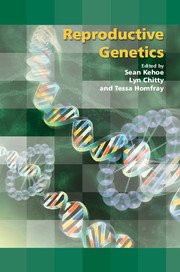Book contents
- Frontmatter
- Contents
- Participants
- Declarations of personal interest
- Preface
- 1 Genetic aetiology of infertility
- 2 Disorders of sex development
- 3 Preimplantation genetic diagnosis: current practice and future possibilities
- 4 Ethical aspects of saviour siblings: procreative reasons and the treatment of children
- 5 Epigenetics, assisted reproductive technologies and growth restriction
- 6 Fetal stem cell therapy
- 7 Prenatal gene therapy
- 8 Ethical aspects of stem cell therapy and gene therapy
- 9 Fetal dysmorphology: the role of the geneticist in the fetal medicine unit in targeting diagnostic tests
- 10 Fetal karyotyping: what should we be offering and how?
- 11 Non-invasive prenatal diagnosis: the future of prenatal genetic diagnosis?
- 12 Non-invasive prenatal diagnosis for fetal blood group status
- 13 Selective termination of pregnancy and preimplantation genetic diagnosis: some ethical issues in the interpretation of the legal criteria
- 14 Implementation and auditing of new genetics and tests: translating genetic tests into practice in the NHS
- 15 New advances in prenatal genetic testing: the parent perspective
- 16 Informed consent: what should we be doing?
- 17 Consensus views arising from the 57th Study Group: Reproductive Genetics
- Index
7 - Prenatal gene therapy
Published online by Cambridge University Press: 05 February 2014
- Frontmatter
- Contents
- Participants
- Declarations of personal interest
- Preface
- 1 Genetic aetiology of infertility
- 2 Disorders of sex development
- 3 Preimplantation genetic diagnosis: current practice and future possibilities
- 4 Ethical aspects of saviour siblings: procreative reasons and the treatment of children
- 5 Epigenetics, assisted reproductive technologies and growth restriction
- 6 Fetal stem cell therapy
- 7 Prenatal gene therapy
- 8 Ethical aspects of stem cell therapy and gene therapy
- 9 Fetal dysmorphology: the role of the geneticist in the fetal medicine unit in targeting diagnostic tests
- 10 Fetal karyotyping: what should we be offering and how?
- 11 Non-invasive prenatal diagnosis: the future of prenatal genetic diagnosis?
- 12 Non-invasive prenatal diagnosis for fetal blood group status
- 13 Selective termination of pregnancy and preimplantation genetic diagnosis: some ethical issues in the interpretation of the legal criteria
- 14 Implementation and auditing of new genetics and tests: translating genetic tests into practice in the NHS
- 15 New advances in prenatal genetic testing: the parent perspective
- 16 Informed consent: what should we be doing?
- 17 Consensus views arising from the 57th Study Group: Reproductive Genetics
- Index
Summary
Summary
Prenatal gene therapy aims to deliver genes to cells and tissues early in prenatal life, allowing correction of a genetic defect before long-term tissue damage has occurred. In contrast to postnatal gene therapy, prenatal application has a number of advantages, including targeting genes to a large population of dividing stem cells, and the smaller fetal size, which allows a higher vector to target cell ratio to be achieved. Early-gestation delivery may result in the fetus developing immune tolerance to the transgenic protein, which would allow postnatal repeat vector administration if needed. Further treatment options include using transduced autologous or allogeneic stem cells to treat congenital fetal disease, or to treat obstetric conditions such as fetal growth restriction by delivering gene therapy to the mother.
Recent advances in vector design and stem cell research have benefited this potential treatment. Although still in the preclinical stage, proof-of-principle studies in animal models of congenital disease, such as the haemophilia mouse, have shown the potential of prenatal gene therapy to cure disease. Investigators have devised delivery strategies in large animals that could be used clinically to apply gene therapy to the human fetus, and prenatal gene therapy may become available for the treatment of certain life-threatening congenital disorders in the near future. In this way, pregnant women and their partners would have a third choice when faced with an affected fetus where currently the only options are either terminating the pregnancy or continuing with an affected fetus with a poor prognosis.
Keywords
- Type
- Chapter
- Information
- Reproductive Genetics , pp. 101 - 122Publisher: Cambridge University PressPrint publication year: 2009



